|
Pivotal World Series Moments
Koosman Outpitches McNally
1969 World Series Game 2: New York Mets @ Baltimore Orioles
The New York Mets joined the National League as an expansion team in 1962. In their first seven years of existence, their best winning percentage was .451 in 1968. But 1969, the first year of the expansion of baseball into two divisions in each league and the Mets' second year under Manager Gil Hodges, they surprised the baseball world by winning the NL East and sweeping the Atlanta Braves, the NL West champions, to make it to the World Series and earn the nickname "The Miracle Mets."
The New York Mets joined the National League as an expansion team in 1962. In their first seven years of existence, their best winning percentage was .451 in 1968. But 1969, the first year of the expansion of baseball into two divisions in each league and the Mets' second year under Manager Gil Hodges, they surprised the baseball world by winning the NL East and sweeping the Atlanta Braves, the NL West champions, to make it to the World Series and earn the nickname "The Miracle Mets."
Their opponent was the mighty Baltimore Orioles, who won the AL East by 19 games over the Detroit Tigers and swept the Minnesota Twins in the American League championship series.
The Orioles were being touted as a reincarnation of the Yankee teams of the fifties and early sixties. Earl Weaver's club was a balanced team with a deep pitching staff, an excellent defense that was widely regarded as the best in either league, and a lineup that hit for average and for power. It was no wonder the oddsmakers installed Baltimore as 8-to-5 favorites.
It didn't surprise anyone that the Orioles won Game 1 4-1 behind the stellar pitching of 23-game winner Mike Cuellar, who bested the Mets' ace Tom Seaver, whose 25 wins led the major leagues. While losing both games in Baltimore wouldn't be the end of the world, the Mets needed a win in Game 2 to show the baseball world—and themselves—that they could compete with the high-flying Orioles.
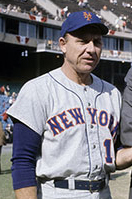  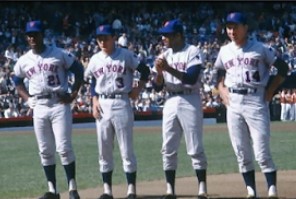 L-R: Gil Hodges, Jerry Koosman, Cleon Jones, Bud Harrelson, Tommy Agee, Gil Hodges Southpaw Jerry Koosman (17-9) had the second-most wins for the Mets during the season. He would duel Baltimore's second-best pitcher, Dave McNally (20-7), also a lefty.
Clendenon Breaks Scoring Ice
Neither team got a hit until the top of the third when Mets SS Al Weis, a .215 hitter during the season, singled. But he didn't make it past second base.
As often happens, the scoreless tie was broken with one swing of the bat. Mets 1B Donn Clendenon clouted an opposite field home run to right field to lead off the fourth. Many Mets fans might have thought, "There's your run, Koosman. Make it stand up."
 Donn Clendenon smashes a homer off Dave McNally. The two hurlers proceeded to set down the next 19 batters. Mets 3B Ed Charles finally broke the streak with a line drive double down the left field line with one out in the seventh. But McNally left him stranded at second.
In the bottom of the 7th, the Orioles finally got a leadoff batter on base when CF Paul Blair singled to left to break up Koosman's no-hitter. Blair stayed at first as the next two hitters went out. Then he stole second, and 3B Brooks Robinson drove him home with a single to center to tie the score.
With neither pitcher showing signs of tiring, both teams went down 1-2-3 in the eighth.
Mets Break Through in 9th
Mets fans began to think they'd have to go to extra innings to win when their first two batters in the ninth went down. But Charles raised their hopes with a single. Then C Jerry Grote followed with another single to send Charles to third. Weis smacked the first pitch for the third straight single to left field to break the tie.
Weis, who rarely enjoyed a two-hit game, said afterward, "Had it been any other manager, I believe I would have been taken out. Gil has stayed with me, and I'm thankful. I'm a quiet type guy—the writers don't usually get as much out of me as they're getting now—but in my own way, I play the game hard."
Weis added, "I was looking for breaking pitches. And the first pitch was a high slider, a bad pitch, and I saw it real well."
Baltimore manager Earl Weaver explained, "I wanted to pitch to him. If I walk Weis, they hit for Koosman. After eight innings, I'd rather face Koosman than a fresh arm. I thought we were getting to him."
Koosman had to face the top of the Orioles order in the bottom of the ninth. He had allowed only two hits to the American League champions. He made quick work of LF Don Buford and Blair. 33-year-old RF Frank Robinson was on the downside of his Hall of Fame career, but he still drove in 100 runs and smacked 32 homers during the season. However, with Koosman working carefully, Frank drew a walk and was replaced by pinch runner Marv Rettenmund. Up came 1B Boog Powell (37 HRs, 121 RBI). He too worked a walk.
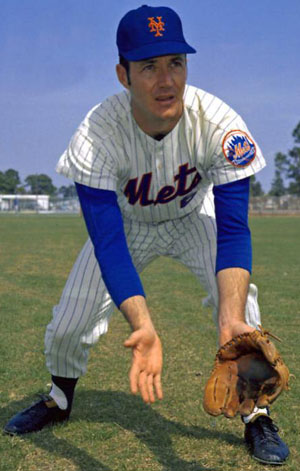 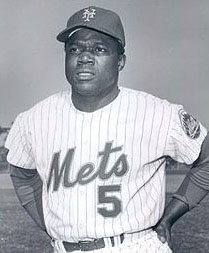 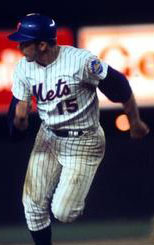  L-R: Al Weis, Ed Charles, Jerry Grote, Ron Taylor Taylor Gets Final Out
With right-hand hitting 3B Brooks Robinson up next, Hodges brought in right-handed P Ron Taylor, who led the Mets with 13 saves, one more than his southpaw bullpen counterpart Tug McGraw. Taylor was the only Met with any World Series experience, which came in 1964 with the Cardinals.
Taylor thought, "If I get Brooks out, we win and go home. If I don't, if he gets a hit, we go into extra innings. Don't get behind him, that's all I was thinking about."
Robinson hit a 3-1 pitch to Charles, who first started to run to third to force Rettenmund. But realizing he might not beat him to the bag, Charles threw to first. Clendenon made a nice scoop out of the dirt to end the nail-biter and even the Series before the teams moved to New York.
"Two steps short," said Brooks Robinson, who was far from the fastest of base runners. "Two steps. That's the story of my life."
FINAL SCORE: METS 2 ORIOLES 1
Postgame
Clendenon said afterward, "I'm tired of everybody telling me how great the Baltimore Orioles are. We're great too. We're the champions of the National League. They're a great ballclub, but we're going to find some way to beat them."
|